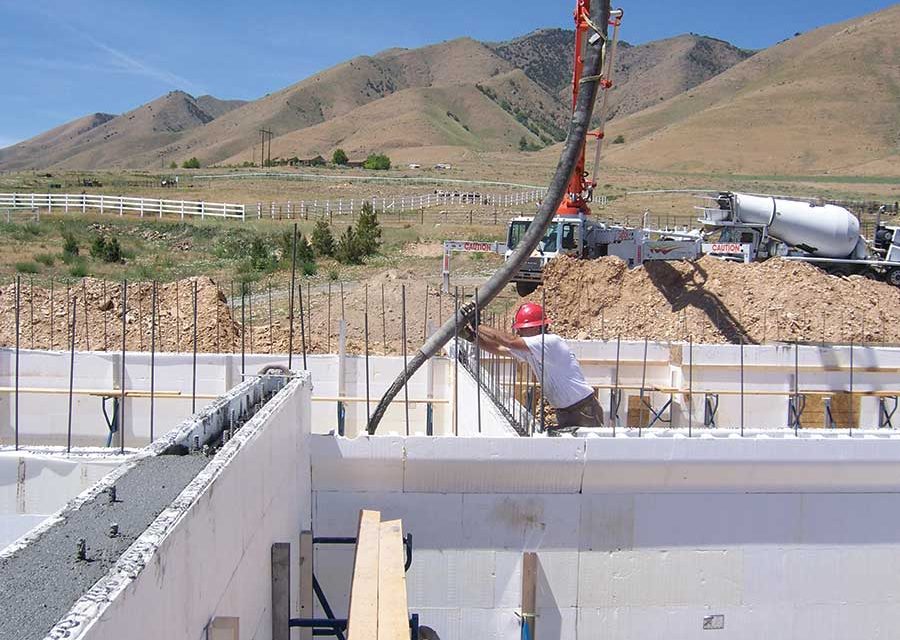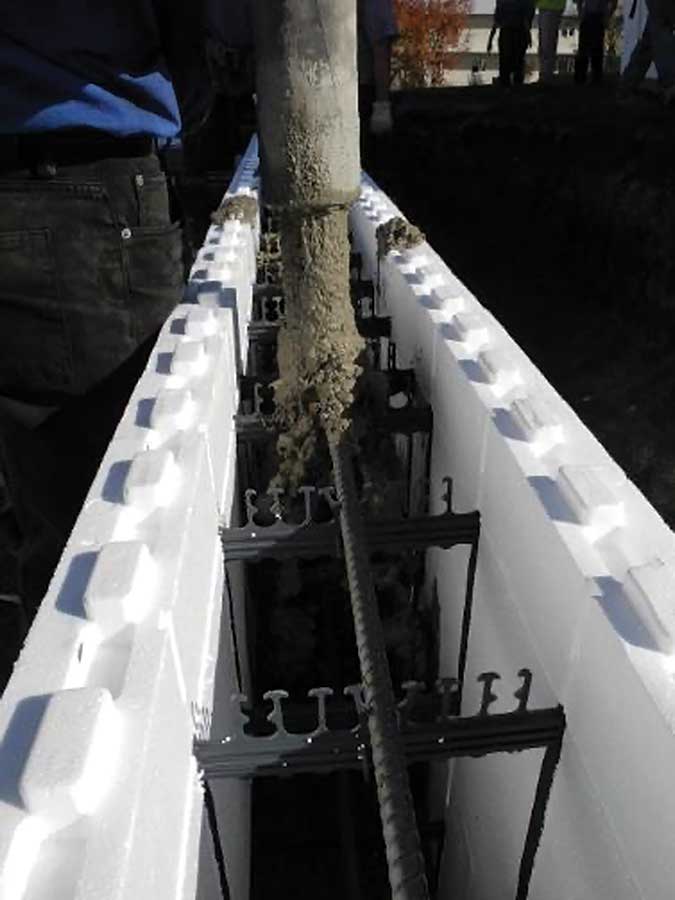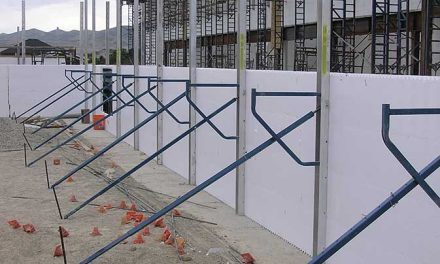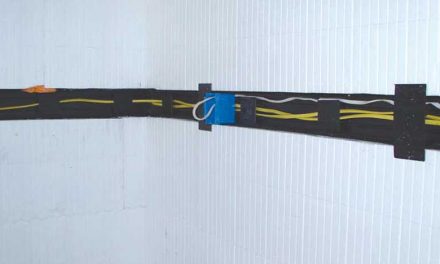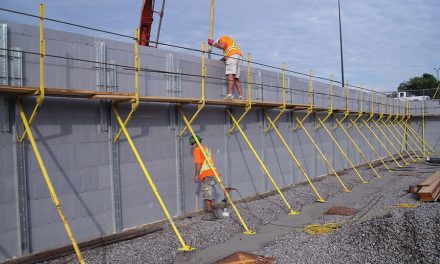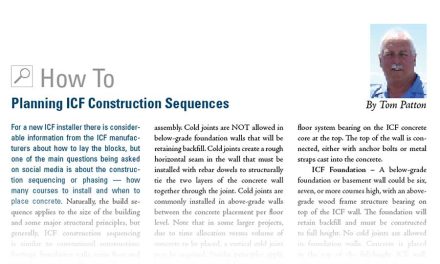The placement of concrete in an ICF wall is the most exciting part of the build.
This stage of the build is not something to be taken lightly and needs to follow engineering rules, material specifications, safety, and placement procedures for success. Check your selected ICF manufacturer’s website for information on both concrete specifications and placement procedures. Contact your local ready-mix supplier to discuss the specifics of the ICF concrete mix design for strength, aggregate size, and slump.
If you have not placed concrete before there are few procedures to follow:
- Follow advice from the ready-mix supplier and pump truck operator.
- Follow specific rules for placement flow rate and placement in lifts, wall heights, etc.
- Ask and take advice from your ICF supplier.
- Find an experienced ICF contractor or concrete contractor that you could hire for the day to do the placement and train you and your crew.
- Hire a trained, experienced ICF contractor to execute or supervise the build.
Understand upfront that once you start to place concrete you are committed to creating structural walls. Concrete is not forgiving with problems or mistakes.
There are several vital pre-planning details that must be taken into account:
- Complete an accurate quantity estimate for the concrete including concrete for the pump truck. Make sure that you have the right quantity and will not come up short at the top of the wall.
- Speak with the concrete supplier to ensure the mix is suited for ICFs with regard to strength, slump, and aggregate size. Understand what “slump” is. Having the wrong slump or aggregate size may damage the ICF during placement. Note that concrete for ICF walls is a totally different mix design than that used for floor slabs.
- After the materials and quantities are established, develop a timing schedule by confirming with the concrete supplier arrival times for trucks for continuous placement.
- Book the pump truck to be on-site and set-up well before the concrete trucks arrive.
- Be prepared for any issues, and have equipment easily accessible and ready.
There are a few basic rules for concrete placement in ICF walls that must be followed. Understand the terminology “cold joint.” This is a rough joint (not trowelled) in the wall where concrete placement has been stopped and the concrete has set. First rule — due to the pressure on below-grade foundations walls from the backfill, cold joints must NOT be used in below grade walls. A cold joint in below grade walls creates a hinge-like effect, compromising the structural integrity of the wall. Below-grade foundation walls and stem walls that support backfill must be a monolithic or a continuous pour from the footing to the top of the wall.
This continuous pour is done in lifts (3-foot to 4-foot layers) continuously around the perimeter of the building until you reach the top of the wall. Placement in lifts minimizes the liquid concrete pressure on the walls, allowing the first lift to start to stiffen and support the next lift. Directly following the concrete placement is the vibrator, consolidating the concrete, removing air, and blending each lift together. This is an important step that must happen before the next lift is placed.
Above-grade walls can have cold joints. These are typically installed between the top of the basement wall and first floor and also between the first floor and second floor walls. Check on the procedure to install cold joints and the requirements to install reinforcing dowels in a cold joint.
Placement day will be very active, with a continuous commitment by the whole crew (recommended minimum of four people) to get the job done right. Prior to this, the day or night before, it is very important to go over a checklist on the walls, all rebar in place, strapping, bracing, embedments, service penetrations, tools ready, vibrator, etc. Also, is the scaffolding set to be able to walk around the entire perimeter to place concrete? It is critical to have everything ready before concrete arrives and starts to flow. Another variable is the weather. Since the whole day is committed to the concrete placement, rain, snow, temperatures (hot or cold), or high winds may influence either the ability for placement, or the concrete itself. Be prepared to address these conditions. Check the day before or first thing the day of to make a decision about whether the pour can proceed.
As part of the time estimate, the physical set-up time for the crew and the equipment must be taken into account. The pump truck must arrive and be ready prior to concrete trucks arriving. Allocate at least 30 minutes or more for this set up. Make sure you have a suitable location for the pump truck to be able to reach all the walls. Talk to the pump truck operator, because they are going to be your best friend for the day. Discuss the placement plan, direction, safety signals, and the driver’s advice on flow rate and concrete slump. When the concrete arrives, check the slump and aggregate are as specified.
The other key element in concrete placement is manpower — one person to place concrete, one person to follow with the internal vibrator for consolidation, and possibly two on the ground monitoring the walls. If you are not using an internal vibrator, then two on the ground vibrating, one on each side of the wall.
Concrete placement has many variables with temperature as one of the main characteristics influencing the mix design and flow rate. Colder temperatures mean a slower flow rate, higher temperatures allow for a faster flow rate. Generally, at 70 degrees F the flow rate is 4 feet per hour. As an example, for an ICF foundation or basement wall, 140 linear feet at 8 feet or 9 feet high, to go around the whole perimeter with a 3-foot or 4-foot lift height may take an hour or more. Continuing with the second lift would be another hour. For a 9-foot-high wall, this would be done in three lifts of 3 feet each.
Generally, foundation walls have fewer and smaller openings than above-grade walls. Openings take a little more time to place the concrete, to make sure it fills at the sill, around all the corners, plus in the lintels. Above-grade walls, with more openings, may take longer for each lift. Estimate at least five minutes extra time for each opening.
Total time allocation for a 9-foot-high foundation wall would be at least 1 hour of prep time to organize the crew and review the pre-pour checklist before the concrete arrives, 3 hours to place and consolidate the concrete, and at least 1 hour to finish the top of the wall, place dowels or anchor bolts, check embedments, adjust the bracing to a string line making the walls plumb and straight, then general clean up. For above-grade walls with more openings, generally, add another hour.
In an effort to save time and money, some installers want to place the concrete in taller wall sections. This is only recommended for ICF installers who have experience with placing concrete in tall walls. There are many more complications with taller walls once you get above 10 feet, i.e., bracing, consolidation, hydrostatic pressure, and general procedures in placing the concrete. Consult your ICF supplier or an experienced ICF installer before proceeding with this plan.
In the planning stage, typically, concrete is placed in the walls on a Thursday or Friday and the walls are left to cure, with the bracing on, over the weekend. In cold weather, the concrete at the top of the wall should be covered.
To assist in concrete placement and consolidation, there are numerous checklists available to be followed for pre-placement and post-placement of concrete. Once you reach this stage of the build, don’t try to reinvent the wheel. Follow ICF material specifications, concrete placement, and consolidation procedures to ensure success. Utilize the knowledge of the ready-mix supplier, the pump truck operator and the ICF manufacturer’s installation instructions.
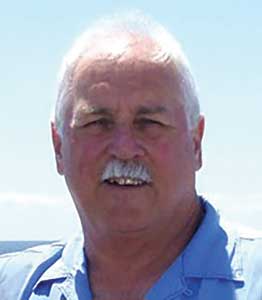
Tom Patton
Tom Patton had a 30-year architectural design background prior to joining the ICF industry in 2001 with the technical support department at ARXX. Over the last 20 years, Tom has worked with major ICF companies developing technical documentation, application details, and training programs, as well as consulting and promoting ICFs with various associations including the ICFMA, NRMCA, and codes and standards committees. Currently, Tom is Corporate Brand Ambassador for Fox Blocks and co-developer of the Fox Blocks Integrated Learning Center.

